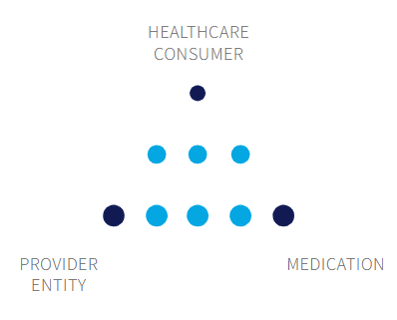Insights
Demystifying the Medication Use Process
A deeper look at The Medication
RevityRx’s medication use process (MUP) model illustrates the interdependent relationships between the stakeholders or nodes involved in the process. The nodes are Provider Entities, Healthcare Consumers, and the Medication. The model aims to simplify the complex MUP and establish a mutual understanding of the nodes at a high level. For a greater appreciation of the process complexity, exploration into each node’s composition will identify MUP levers to transform a siloed collection of activities into a comprehensive medication stewardship framework. This insight highlights the medication elements that influence clinical, operational, and consumer experience.

What comprises the Medication node?
The Medication node is a compendium of medications and the programs offered by pharmaceutical companies to enhance therapeutic outcomes. Each individual medication is a product of the research and scientific evidence to support its condition-specific use and is often part of a group of medications approved for the same therapeutic use or within the same therapeutic category. The compendium of medications is integral to medication use decision making within Provider Entities and impact Healthcare Consumers.
For some medications, pharmaceutical companies serve as the conduit to disseminate clinical and drug information to Provider Entities and Healthcare Consumers. Programs such as Patient Assistance Programs (PAPs) and Patient Success Programs (PSPs) that wrap services around a specific therapy or condition aim to improve patient outcomes and strengthen provider and patient relationships. While these programs can further differentiate therapy, they lie outside the control of Provider Entities and Healthcare Consumers.
How does the Medication fit into the MUP model?
The Medication node is the least dynamic within the MUP model as Provider Entities and Healthcare Consumers assume responsibility for the overall MUP. Inclusion or exclusion of a therapeutic class or specific medication depends on the needs of the patient and therapeutic goals.
In RevityRx’s MUP model, the Medication serves as a guide or frame of reference that influences how the Provider Entity and Healthcare Consumer nodes interact with the MUP. Within the acute and ambulatory settings, there are many scenarios where the Medication node affects the MUP. Examples include:
- Use of a medication with a high side effect potential.
- The patient’s insurance no longer covers maintenance medication.
- Medication shortage impacts availability.
- Home medication substituted for formulary medication while in the hospital.
- New medication initiated following a hospital encounter.
These scenarios influence multiple MUP activities such as medication history documentation, medication reconciliation, therapeutic monitoring, patient education, and medication accessibility and affordability strategies. The Medication impacts the Healthcare Consumer and Provider entities decision making on use of assets to promote positive outcomes.
Further exploration into the composition of each node of RevityRx’s MUP model will help clients identify levers to transform the MUP into a comprehensive medication stewardship framework. Learn more at www.revityrx.com.

